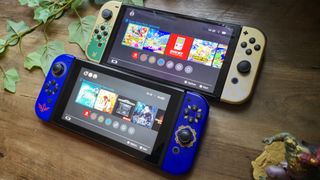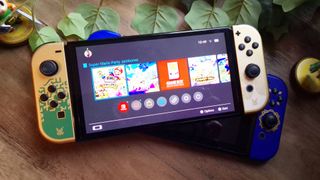Nintendo Switch 2: The Anticipation for OLED Brilliance
As the gaming community buzzes with excitement for the potential reveal of the Nintendo Switch 2, it’s hard not to feel a palpable sense of anticipation. Recent Nintendo Direct presentations may have left us with little about the successor, but the whispers of hardware enhancements only serve to fuel the fire. The prospect of a new console boasting double the RAM at 8GB tantalizes many, yet it’s the display that holds the most significance for avid gamers like myself.
 Could the next-generation handheld offer an OLED experience?
Could the next-generation handheld offer an OLED experience?
Without a doubt, one of the most thrilling aspects of any gaming handheld is the display. Industry analysts have hinted at an 8-inch LCD screen for the upcoming device. Hiroshi Hayase, speaking to Bloomberg, voiced concerns that the beloved OLED screens may be absent from this latest iteration. Meanwhile, tech giant Sharp seems to be in the mix, revealing efforts towards developing an LCD display for a “new gaming console.”
While I cherish my original Switch, with its 6.2-inch LCD panel that brought vibrant worlds like those in Super Mario Odyssey and Splatoon 2 to life, the evolution of technology prompts a craving for something better. In fact, this desire was amplified significantly after the introduction of the Nintendo Switch OLED model.
The Glow of OLED
The arrival of the OLED Switch was a game-changer. Bringing larger storage and fresh aesthetics, the true star of the show was its stunning 7-inch OLED screen. My initial reluctance to switch from my precious LCD model faded when I got my hands on the The Legend of Zelda: Tears of the Kingdom edition. The striking colors and richer contrasts that OLED technology affords made Tears of the Kingdom an unforgettable experience, far from what was possible with the original LCD screen.
“Once you go OLED you can’t go back.”
These words resonate deeply with anyone who has experienced the transition firsthand. While Tears of the Kingdom looks gorgeous on any model, playing it on the OLED makes each shade of green leap off the screen, making the vast landscapes of Hyrule even more breathtaking. The contrast between the depths of shadows and bright highlights transforms gameplay into a visually immersive journey. Besides Zelda, titles like Mario Kart 8 Deluxe feel alive and electric, especially when racing through the vibrant DLC courses on that richly saturated display.
 Exploring the wonders of OLED technology in gaming.
Exploring the wonders of OLED technology in gaming.
Shifting back to the LCD feels akin to trying to revive an old, faded memory. The original setup was a fantastic experience in its time, but it simply cannot stand up to the splendor and clarity provided by its OLED successor. In an age where hardware innovation in portable gaming feels robust, moving back to LCD seems increasingly difficult to fathom.
The Price of Progress
One significant question arises: how much are we willing to pay for this extraordinary tech? Nintendo has historically kept their launch prices lower than their competitors—such as the PlayStation 4—but with the increasing demand for superior displays, will they change their approach? The original Switch launched at around $299, while competitors hovered around the $399 mark.
Since its debut in 2017, many portable consoles have adopted OLED displays, noticeably the Steam Deck, which transitioned from an LCD to an OLED upgrade. This change highlights the industry trend towards enhancing portable gaming devices. However, such improvements typically come at a higher price point, making the OLED models significantly more expensive than their LCD predecessors.
In essence, gaming enthusiasts might very well be at a crossroads; if the Switch 2 launches with a basic LCD, it might leave many pondering whether to delay their purchase in hope of a future OLED iteration. While previous consoles lacked immediate OLED models, we are witnessing a growing consumer preference for enriched screens, making this decision critical.
Today, the landscape of handheld gaming teeters on the brink of transformation. If Nintendo aims to stay ahead, we can only hope they recognize the value of OLED technology and its importance to their loyal user base.
 The evolution of handheld devices and displays.
The evolution of handheld devices and displays.
As we wait for the official announcements and hope for OLED in the upcoming Switch 2, it’s worth pondering how significantly a new screen technology can enrich our gaming experiences. The journey through Hyrule, the thrill of racing, and even simple menu navigation can feel entirely different with the right display technology. Only time will tell if Nintendo will meet the fans’ expectations or if the quest for enhanced visuals will lead us to a future OLED model.
In the meantime, savvy shoppers might want to look for the best Nintendo Switch OLED deals available as we continue our gaming odyssey.














